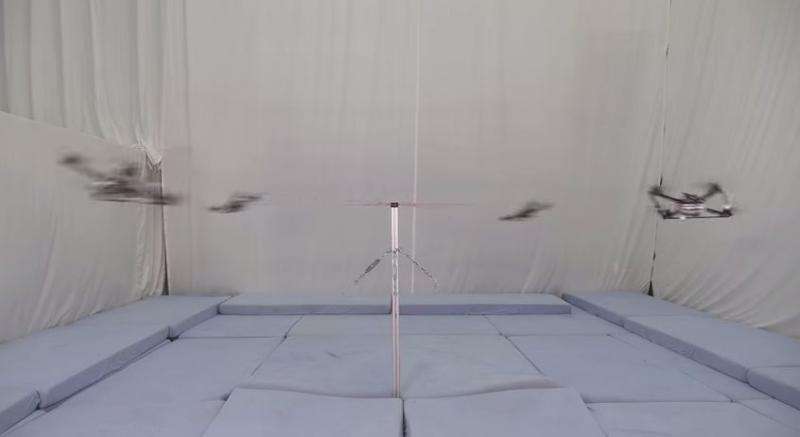May 8, 2015 weblog
Zurich team shows high-speed tethered quadrocopters (w/ Video)

A video has emerged which shows quadrocopters tied to a pole with rope, and they perform something called "cooperative acrobatics." IEEE Spectrum's Evan Ackerman said Thursday that watching the quadrocopters go around in circles as they do is not boring. Dizzying but not boring.
The quadrocopters are carefully tracked with a motion capture system. Ackerman said they top out at more than 50 kilometers per hour while flying in a circle with a radius of just 1.7 meters. To keep them from "flying off into oblivion," said Ackerman, a tether exerts over 13 gs of centripetal force.
The researchers behind the exercise are focused on exploring the machines and are also exploring the limits of their attempt. They are giving the quadrocopters their workouts at the Flying Machine Arena at ETH Zurich. This is a space marked for autonomous flight. With their high-precision motion capture system, wireless communication network and custom software, the researchers leverage the arena to offer them a safe and controlled sandbox environment where they test and validate mobile robots. The arena space allows for tests of fast-paced motions, on the ground or in the air.
The Flying Machine Arena web site tells viewers that their motion capture system can locate multiple objects in the space at rates exceeding 200 frames per second. Objects in the space can move at speeds in excess of 10 m/s, resulting in displacements of over 5 cm between successive snapshots. The information is fused with other data and models of the system dynamics to predict the state of the objects into the future. The system uses this knowledge to determine what commands the vehicles should execute next to achieve their desired behavior. Via wireless links, the system sends the commands to the vehicles. They execute them with on-board computers and sensors, such as rate gyros and accelerometers.
In notes that accompany the video of these tethered quadrocopters, flying together at high speeds in a confined space, Maximilian Schulz, one of the researchers, noted that "Due to the centripetal force exerted by the tether, high-speed trajectories along circles at different orientations in space can be flown. Velocities exceeding 50 km/h and centripetal accelerations of more than 13 g are achieved in steady flight, within a sphere of radius 1.7 m." The quadrotors fly information across different orientations. They also perform together in a braking maneuver.
Ackerman wrote about the learning advantages in this tethered environment. "At ETH Zurich, the ability to do this is helping them get familiar with how quadrocopters handle at very high speeds, how big of an issue drag is, the efficiency of different propeller designs, and stuff like that. Also, it gives them a chance to practice controlled maneuvering at high speed, including the emergency braking that's featured in the vid."
Schulz said it was possible to take away the central pole by balancing the forces acting on the strings; this could be used in performance settings, possibly enhanced by light and sound effects.
The researchers are Maximilian Schulz, Federico Augugliaro, Robin Ritz, and Raffaello D'Andrea, from the Institute for Dynamic Systems and Control (IDSC), ETH Zurich, Switzerland. Their study, "High-speed, Steady Flight with a Quadrocopter in a Confined Environment Using a Tether," has been submitted to IROS 2015. This International Conference on Intelligent Robots and Systems will take place in Germany later this year.
© 2015 Tech Xplore




















